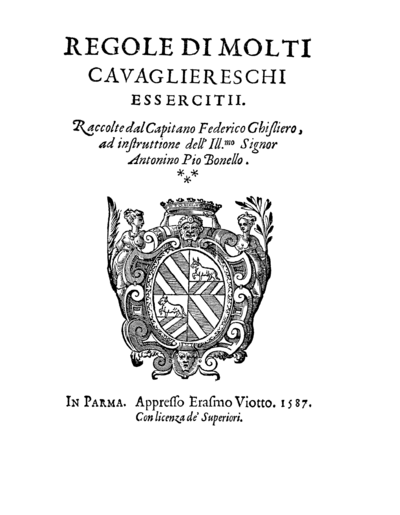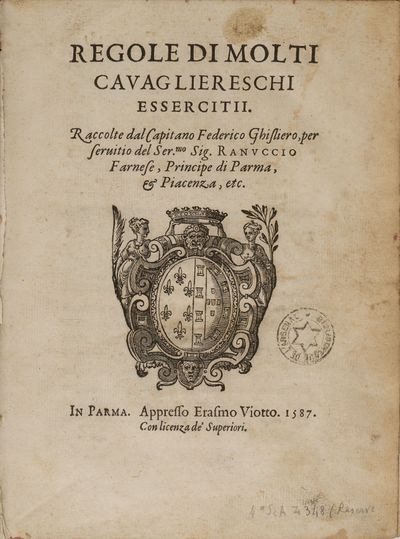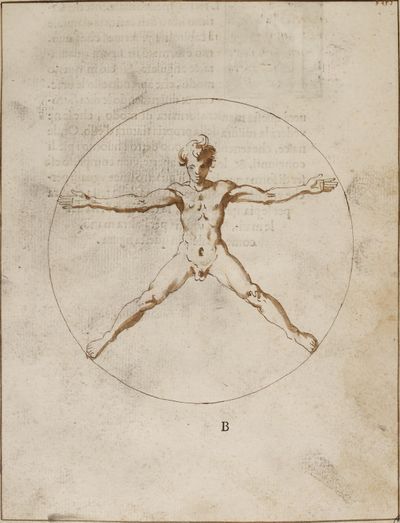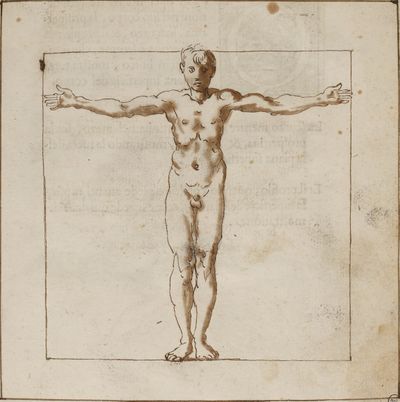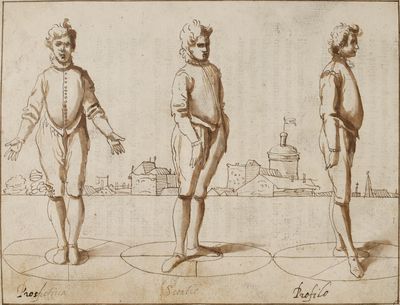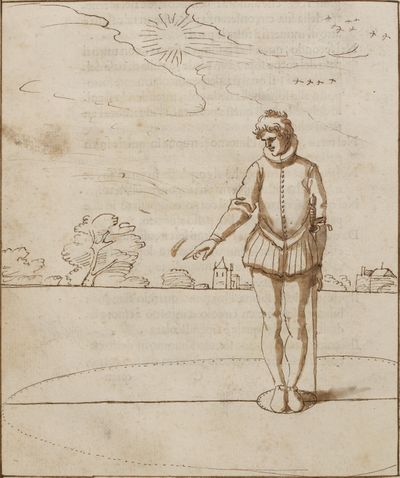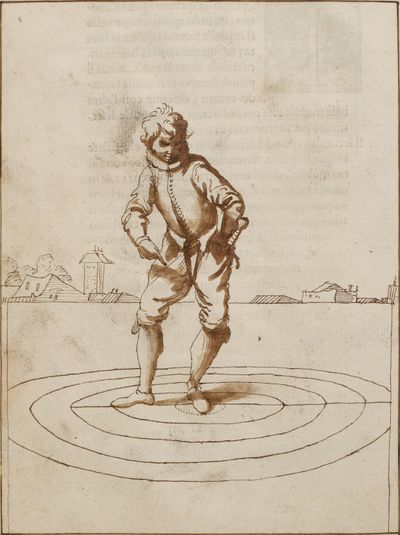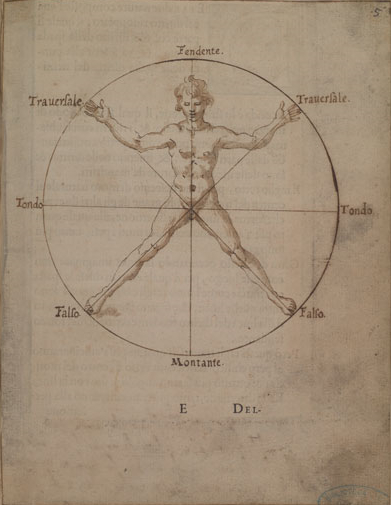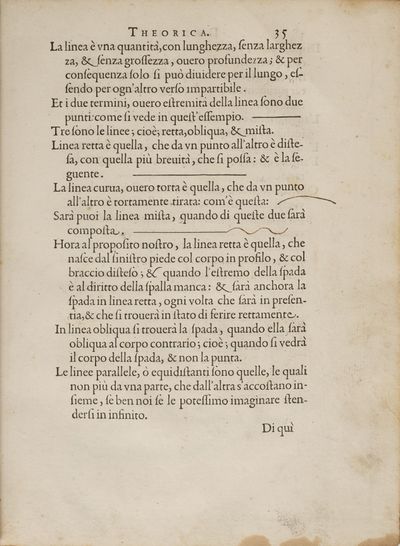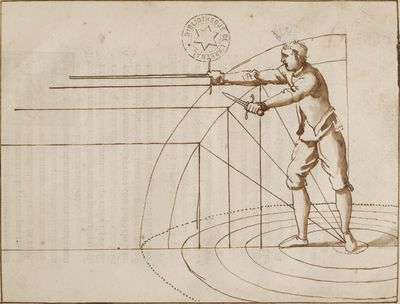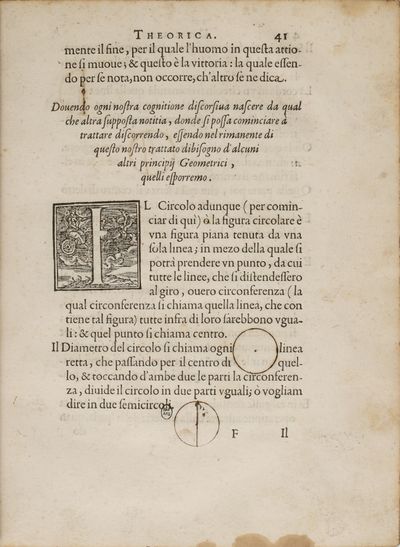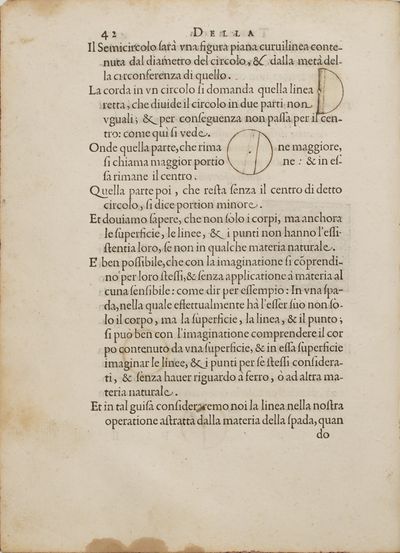|
|
You are not currently logged in. Are you accessing the unsecure (http) portal? Click here to switch to the secure portal. |
Federico Ghisliero
| Federico Ghisliero | |
|---|---|
| Died | 1619 Turin, Italy |
| Occupation |
|
| Nationality | Italian |
| Genres | Fencing manual |
| Language | Italian |
| Notable work(s) | Regole di molti cavagliereschi essercitii (1587) |
Federico Ghisliero was a Bolognese soldier and fencer. Little is know about his early life, but he studied fencing under the famous Silvio Piccolomini.
In 1587, he published a fencing treatise called Regole di molti cavagliereschi essercitii, dedicated to Ranuccio Farnese, who was 18 years old at the time of publication and would become Duke of Parma, Piacenza, and Castro. Ghisliero's manual is notable for his use of geometry in relation to fencing, and the incredibly detailed illustrations, using concentric circles centered on where the fencer has placed most of their weight (often, but not always, the back foot), and illustrating multiple versions of each figure in a plate, showing the progression of the movements he describes.
Treatise
Temp
Images |
Transcription | |
|---|---|---|
For further information, including transcription and translation notes, see the discussion page.
| Work | Author(s) | Source | License |
|---|---|---|---|
| Images | Bibliothèque nationale de France | ||
| Translation | Nicola Boyd | Rules of many knightly armies | |
| Transcription | Nicola Boyd | Index:Regole di molti cavagliereschi essercitii (Federico Ghisliero) |
Additional Resources
The following is a list of publications containing scans, transcriptions, and translations relevant to this article, as well as published peer-reviewed research.
- Anglo, Sydney (1994). "Sixteenth-century Italian drawings in Federico Ghisliero's Regole di molti cavagliereschi essercitii." Apollo 140(393): 29-36.
- Gotti, Roberto (2023). "The Dynamic Sphere: Thesis on the Third State of the Vitruvian Man." Martial Culture and Historical Martial Arts in Europe and Asia: 93-147. Ed. by Daniel Jaquet; Hing Chao; Loretta Kim. Springer.
References
- ↑ 1.0 1.1 Cavagliereschi is Corsican for "chivalrous", while the Italian is "knightly".
- ↑ La gratia is Catalan for "grace".
- ↑ Ghisliero is telling his reader that he is a soldier not a civilian swordsman, so it will have a different perspective to others, hence his later comments on siege craft. [note from Henry Fox]
- ↑ This and the previous paragraph are commending the work to the patron, justifying the work’s existence and its purpose, common in treatises of the period. [note from Henry Fox]
- ↑ It was common to refer to “ancients” in the justification of the art of swordsmanship. [note from Henry Fox]
- ↑ When ‘this art’ or ‘the art’ is referenced it means the art of fencing. [More expansively the ars militari (military arts) or for the more classical, the Arts of Mars, of which swordsmanship falls within.] [note from Henry Fox]
- ↑ Further justification by demonstration of the benefits to those who practice the art in question, also common, especially referring to defense of the person and the realm. [note from Henry Fox]
- ↑ The version dedicated to Antonino instead reads "...for the instruction of the Most Illustrious Lord Antonio Pio Bonello".
- ↑ Cavalier – cavaliere – knights – so indicating the noble nature of the art which he is presenting. [note from Henry Fox]
- ↑ The Humours.
- ↑ Means sad.
- ↑ Means calm.
- ↑ Means optimistic.
- ↑ Means bad-tempered.
- ↑ Hot-tempered.
- ↑ Moti has a number of meanings in modern Italian aside from "motion", including "motorcycle, bike, watercraft, riot, scooter".
- ↑ The use of square brackets [] shows the insertion of the translator to aid in clarity of meaning throughout the document.
- ↑ Contextually, transportar is in modern Italian trasporto and has been translated such.
- ↑ Where the word operante which means the operator or the person taking action or more simply the will is used elsewhere, I translate it to fencer as operator has the wrong connotations in English for what Ghisliaro appears to wish to convey.
- ↑ This is an application of Aristotle’s Causes, in some ways more easily explained due to the application of the sword (though this could be my fencer’s brain), especially as it develops. Ghisliero uses seven rather than four as Aristotle does, or at least using the same method of explanation. [Henry Fox]
- ↑ The spelling of secóda is seconda in modern Italian. This shortening of words through the removal of ‘n’ is common in documents of the period.
- ↑ Public roads means the location is a public road.
- ↑ Of Vitruvius’ Ten Books on Architecture. [This same book is referenced in Thibault] [note from Henry Fox]
- ↑ Or capacity.
- ↑ Flavius Vegetius Renatus' On Roman Military Matters is likely the text to which he is referring. Which was a fourth century commentary on the training of Roman legions harking back to older methods. [note from Henry Fox]
- ↑ Onde is Catalan. It is dove in Italian. Both mean ‘where’ in English.
- ↑ A second century book written by a Roman in the Attica region which encompasses the city of Athens.
- ↑ Dodrans is a Latin contraction of de-quadrans which means “a whole unit less a quarter” or three-quarters.
- ↑ Referencing the ‘ancients’ for authority was commonly used by authors of the time to demonstrate their comprehensive knowledge of the subject. It is intended to add gravitas to the treatise.
- ↑ All’hora is Catalan. Modern Italian is al tempo.
- ↑ The Elder.
- ↑ Scriue is Catalan. Modern Italian is lui scrive.
- ↑ Scurzo, does not translate appropriately from Italian. As with a number of words in Ghisliero’s treatise, it is likely a Catalase word or a unique spelling. Analysis of other treaties such as Jarod Kirby’s Italian Rapier Combat (Kirby, 2004) shows the following two definitions, on page 14 of the text, of a similar sound word that is contextually a more likely approximation of what scurzo means; “Scanso, A voidance, any evasive manoeuvre that moves the body of the direct line” and “Scanso del pie dritto, A voidance made by moving the right foot slightly off the direct line while turning the body.” So for the purposes of this translation, scurzo will mean in this text the middle stance as shown in Figure 3, i.e. a partial voiding stance halfway between perspective and profile.
- ↑ "Perspective" means front facing forward.
- ↑ Also could be interpreted as "figure".
- ↑ George Silver’s theory of the time for the hand and foot from his 1599 text Paradoxes of Defense mirrors this framework. [note from Henry Fox] (Silver, 1599)
- ↑ Et is Latin for ‘and’ in English and e in Italian.
- ↑ This is not an exact translation – it is the best approximation based on context.
- ↑ Balancia translates into ‘balance’.
- ↑ Membro translates to ‘member’, but in English a better word is limb.
- ↑ ò á mano manca la fontanella directly translates to something like ‘the hand missing the fontanelle’. This made no contextual sense, so it has been translated to ‘from the fountain of the body’ as fonta can mean ‘source’ in modern Italian. In the it states that “Fontánella, a little fountaine. Also a fontanell or cauterie [something to cauterise wounds], or rowling [turning round about, whirling or turning round], used also for the chiefe vein of a man’s body.” (Florio, 1611)
- ↑ ‘Perspective’ is forward facing as can be seen in Figure 3.
- ↑ No good translation found, contextually translating spatio to ‘space’.
- ↑ Polykleitos's Doryphoros is an early example of this position called contrapposto. See https://en.wikipedia.org/wiki/Polykleitos for examples of sculptures with this stance. (Wikipeadia, 2021)
- ↑ Polykleitos wrote a lost treatise called ‘Artistic canons of body proportions’ in 5th Century Greece which provided a reference for standard body proportions. For more information https://en.wikipedia.org/wiki/Artistic_canons_of_body_proportions (Wikipeadia, 2021)
- ↑ The act or process of passing across, over, or through.
- ↑ Aristotle’s fifth book of the Physica, which considers how motion occurs. “Book V classifies four species of movement, depending on where the opposites are located. Movement categories include quantity (e.g. a change in dimensions, from great to small), quality (as for colours: from pale to dark), place (local movements generally go from up downwards and vice versa), or, more controversially, substance. In fact, substances do not have opposites, so it is inappropriate to say that something properly becomes, from not-man, man: generation and corruption are not kinesis in the full sense.” (Aristotle, Physica (Book 5), (384–322 BC) 2007) “Generally things which come to be, come to be in different ways: (1) by change of shape, as a statue; (2) by addition, as things which grow; (3) by taking away, as the Hermes from the stone; (4) by putting together, as a house; (5) by alteration, as things which ‘turn’ in respect of their material substance.” Book 1, Physica, Aristotle (Aristotle, Physica (Book 1), (384-322 BC) 2007)
- ↑ Change of shape.
- ↑ By addition or by growing.
- ↑ Also taking away or removing.
- ↑ Putting things together or building.
- ↑ Change of material substance or alteration of its substance.
- ↑ “Three kinds of motion - qualitative, quantitative, and local” Book 5, Physica, Aristotle (Aristotle, Physica (Book 5), (384–322 BC) 2007)
- ↑ This same concept is present in Chapter 5 ‘Of tempo’ in Ridolfo Capo Ferro da Cagli’s 1610 publication Gran Simulacro dell'Arte e dell'Uso della Scherma and can be translated into the actions of the fencer undertaking the correct movements - from ward (stillness) to attack or defence (movement) to ward (stillness) again. It propounds that the fencer should always end an action in a ward. The same concept is raised in Angelo Viggiani dal Montone’s 1551 (published 1575) text Lo Schermo d'Angelo Viggiani (Montone, 1575) and Antonio Manciolino’s 1531 Opera Nova (Manciolino, 1531).
- ↑ "Violence" in this instance means outside force or against nature. The same concepts of natural and violent actions are used in Iberian swordsmanship, and they take higher guards to take advantage of this principle. [note from Henry Fox]
- ↑ Springimento is likely Springáre means ‘yarke, kicke or winze’ (Florio, 1611). Which likely means in context a preparation or a marshalling of position prior to deployment.
- ↑ Fighting at the barriers was a form of tournament bout usually performed by armoured combatants in which: a fence, a barrier, was imposed between fencers, combatants fought over the fence, and blows below the waist did not count as tournament points. [note by Henry Fox]
- ↑ Bases mean "legs". I have used "legs" wherever relevant in the translation.
- ↑ “Lacertoi, the arme from the elbow to the pitch of the shoulder. Also the brawne of sinnewes or muskles of a mans armes or legges. Also a Lizard. Also a Muskle because it is like a Lizard. Also a certain disease in a harse amongs the muskles and sinnuewes. Also a fish that grunteth as a Hog. Some have taken it also for a makrell fish.” (Florio, 1611) Thus lacertoi will be translated as the arm from the elbow to the shoulder joint.
- ↑ Keeping the elbow near the body.
- ↑ “Rascetta, the wrist of one’s hand. Also a kind of fine silke-rash.” (Florio, 1611)
- ↑ Direct translation is ‘good blade’.
- ↑ Costa “the back of a knife or weapon.” (Florio, 1611) There isn’t a common English equivalent which is a single word.
- ↑ This is consistent with Giacomo di Grassi’s treatise Ragione di adoprar sicuramente l'Arme (Grassi, 1570) which states that there is more power existing at the circumference of a circle than there is closer to the centre. [note from Henry Fox]
- ↑ Debole refers to the half of the blade from tip of the blade to one third down towards the hilt.
- ↑ Forte refers to the first third of the blade from the hilt to towards the tip.
- ↑ Placing the edge over the debole like this is the basis of the Italian gaining stringere of the sword, or the Spanish atajo. It's used to close and control the line to prevent the opponent from hitting us. [Note by Táriq ibn Jelal ibn Ziyadatallah al-Naysábúrí]
- ↑ Here Ghisliero’s methods conforms to common Italian approaches of defence to: always counter an opponent’s attacks with consideration for returning the attack, always attack with concern for defence, and not attack unless secure against the opponent’s attack. [note from Henry Fox]
- ↑ Justifications for use of the cut seem to be relatively rare in fencing treatise of the time. Ghisliero’s justifications may even be unique. [note from Henry Fox]
- ↑ The same justification for the thrust is given for the thrust being used by the legionary with the gladius, remaining more covered and it being more deadly than the cut. [note from Henry Fox]
- ↑ Fendente means vertical cut.
- ↑ Traversale – transversal or diagonal cut [sometimes squalembrato for downward or falso if rising] [note from Henry Fox]
- ↑ Tondo – horizontal cut
- ↑ Dritti – straight/forward [forehand cut, or natural cut, sometimes called mandritta] [note from Henry Fox]
- ↑ Roversi – reverse [backhand or cross-wise cut] [note from Henry Fox]
- ↑ The division for the cuts on most diagrams usually go through the navel, or heart rather than the groin in most treatise of the period. [note from Henry Fox] Gérard Thibault d'Anvers’ 1630 treatise Academie de l'Espée ‘Book 1 – Tableau/Plate 2 – Comparing the ideal figure to a real Figure; Sword Scabbards’ shows the division at the naval (d'Anvers, Academie de l'Espée, 1630) – in the text it is found in the section that begins Pour venir à la Pratique de tout ce qui a efté discouru, or “To come to the Practice of all that has been discussed” (d'Anvers, Academie de l'Espée – Book 1 – Tableau/Plate 1 – Philosophical Discussion; Construction and Mathematics of the Circle; Concerning the Sword: Proper Length and Introduction explanation of the first plate., 1630). Salvator Fabris, in his 1606 text, Sienza e Pratica d’Arme also has an illustration in the section Discorso sopra laprima guardia formata nel cauare la spada del fodero or “Discourse in the first guard formed in pulling the sword from the scabbard” demonstrates the where cuts should be made and these also shows the division at the navel rather than the groin. (Fabris, 1606)
- ↑ Diritto ridoppiato literally means right redoubled or a falso traversale meaning a diagonal rising cut.
- ↑ Stramazzóne means a circular cut where the hand is the centre of rotation for the cut. [Note by Táriq ibn Jelal ibn Ziyadatallah al-Naysábúrí] Florio describes it as ‘Stramazzóne, a downe-right blow. Also a rap, a cuffe or wherret on the cheeke.” (Florio, 1611)
- ↑ ‘Molinello, or Molinelli means a circular cut. [Note by Táriq ibn Jelal ibn Ziyadatallah al-Naysábúrí] As an aside, the Molinello for flags described in Francesco Fernando Alfieri’s 1638 treatise La Bandiera “The molinello is delightful. To perform it comfortably, you should have the standard in your right hand. You complete a full turn above the head, then throw it up in the air, catching it around the middle of the standard as the figure shows. The molinello is then turned towards the rear foot. After several rotations, as the hand becomes fatigued, you should grip the butt of the flag with your other hand and repeat the same lesson, again throwing it in the air as described above.” (Alferi, 1638)
- ↑ ‘World’ is translated from the word Mondo which means “the world, the universe. Also, a Mound or Globe, as Princes hold in their hands. Also, cleane, cleansed, pure, neate, spotlesse, purged. Also, pared, pilled. Also, winnowed, &c. Also, as we say, a world, a multitude or great quantitie.’ (Florio, 1611)
- ↑ Fendente tondo means the upper half of the circle as shown in figure 6B. When speaking of the reverses, he is speaking of the lower half of the circle in figure 6B.
- ↑ ‘Segáre, to sawe. Also to part, to cut or devide through the middle.’ (Florio, 1611)
- ↑ ‘Riversa’ [singular] t de’roversi, which means ‘to turn around, a reversion, reverting, reverse or a backblow. A powering down or overwhelmed’ – in short the riversa is a back-hand. (Florio, 1611) Note how even the cut from the wrist is aided by motion of the body, no doubt using the feet to move the body as the cut is made as well, all in their correct motion, to affect the cut. [Note from Henry Fox]
- ↑ Imbroccata means a descending thrust. Stoccata, means a violent thrust ascending or rising. Punta riversa means a reverse thrust with the point of the sword.
- ↑ “Auentáta, a hurling, looke Auentáre.” (Florio, 1611) “Auentáre, to hurle, to fling, to dart or cast with violence. Also, to leape or seaze greedily upon, to souse downe as a hawke, also to fill or puff with winde.” (Florio 1611 Dictionary). Therefore imbroccata aventata or imbroccata aventate means to violently attack using a thrust of the rapier over the dagger.
- ↑ The first two lines on the page are printed, but the second two needed to be drawn in by the artist.
- ↑ Here the page numbers jump from 35 to 38, correcting the error of having two 32s and 33s
- ↑ This is the reason that the direct thrust from the shoulder in a straight line is the longest and most preferable and the reason to learn to thrust straight rather than aiming up toward the head. [Note by Henry Fox]
- ↑ 89.0 89.1 89.2 89.3 89.4 89.5 There is a gap in the text here for a circle to be drawn in.

